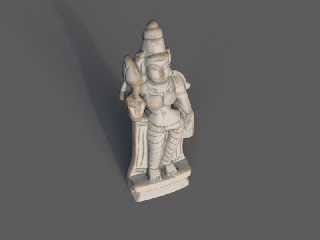 |
 |
|
 |
|
 |
|  |
|  |
|
 |
|
 |
|  |
|  |
|
 |
Back to some work on my grime and edge wear. I think I may be close to what I
want. My previous thought on edge wear had some pitfalls it it, basically due
to how I was trying to implement it, I wouldn't get much, if any, falloff. Then
I realized, all I really need to do us use the crevice grime inside out: a bump
on the outside is a crevice on the inside. This works out much better and gives
some transition dependent on the settings. All I need to do is reverse my
control angle and surface offset in the crevice texture. The only Issue I can
potentially see is with unioned (non-merged) CSG where an 'internal' surface may
interfere with the tracing. Here is a sample with both some edge wear and
crevice grime.
I will likely try to clean up and document my macro to post for others to play
with or modify soon.
-tgq
Post a reply to this message
Attachments:
Download 'creviceedge.jpg' (170 KB)
Preview of image 'creviceedge.jpg'

|
 |
|  |
|  |
|
 |
|
 |
|  |
|  |
|
 |
On 03/27/2011 12:59 PM, Trevor G Quayle wrote:
> Back to some work on my grime and edge wear. I think I may be close to what I
> want. My previous thought on edge wear had some pitfalls it it, basically due
> to how I was trying to implement it, I wouldn't get much, if any, falloff. Then
> I realized, all I really need to do us use the crevice grime inside out: a bump
> on the outside is a crevice on the inside. This works out much better and gives
> some transition dependent on the settings. All I need to do is reverse my
> control angle and surface offset in the crevice texture. The only Issue I can
> potentially see is with unioned (non-merged) CSG where an 'internal' surface may
> interfere with the tracing. Here is a sample with both some edge wear and
> crevice grime.
Wow Trevor, top drawer ... don't you just love it when you discover
another trick use for something you've already been doing? I mean adapt
crevice grim for use as edge wear! Must have been an epiphany ... was
there a heavenly chord in the background ;-)
>
> I will likely try to clean up and document my macro to post for others to play
> with or modify soon.
Yep ... that's something I'd like to have a look at!
Jim
Post a reply to this message
|
 |
|  |
|  |
|
 |
|
 |
|  |
|  |
|
 |
"Trevor G Quayle" <Tin### [at] hotmail com> wrote:
> Then I realized, all I really need to do us use the crevice grime inside out: a >
bump on the outside is a crevice on
the inside.
Truly :)
Weren't you originally using multiple objects for this? If that is still the
case, your method would be useful in situations where one might want to chip
away the outer edges of an object with other objects. The chips could be
height_fields oriented to the normals of the main object....
Sam com> wrote:
> Then I realized, all I really need to do us use the crevice grime inside out: a >
bump on the outside is a crevice on
the inside.
Truly :)
Weren't you originally using multiple objects for this? If that is still the
case, your method would be useful in situations where one might want to chip
away the outer edges of an object with other objects. The chips could be
height_fields oriented to the normals of the main object....
Sam
Post a reply to this message
|
 |
|  |
|  |
|
 |
|
 |
|  |
|  |
|
 |
"Samuel Benge" <stb### [at] hotmail com> wrote:
> "Trevor G Quayle" <Tin### [at] hotmail com> wrote:
> "Trevor G Quayle" <Tin### [at] hotmail com> wrote:
> > Then I realized, all I really need to do us use the crevice grime inside out: a >
bump on the outside is a crevice
on
> the inside.
>
> Truly :)
>
> Weren't you originally using multiple objects for this? If that is still the
> case, your method would be useful in situations where one might want to chip
> away the outer edges of an object with other objects. The chips could be
> height_fields oriented to the normals of the main object....
>
> Sam
Yes, I was originally using mesh2 squares, but to get a good resolution, it
would call for *many* individual objects.
Now you've got me thinking again though, I could probably adapt some of my
existing code to generate a single procedural mesh that could be used for
differencing...
-tgq com> wrote:
> > Then I realized, all I really need to do us use the crevice grime inside out: a >
bump on the outside is a crevice
on
> the inside.
>
> Truly :)
>
> Weren't you originally using multiple objects for this? If that is still the
> case, your method would be useful in situations where one might want to chip
> away the outer edges of an object with other objects. The chips could be
> height_fields oriented to the normals of the main object....
>
> Sam
Yes, I was originally using mesh2 squares, but to get a good resolution, it
would call for *many* individual objects.
Now you've got me thinking again though, I could probably adapt some of my
existing code to generate a single procedural mesh that could be used for
differencing...
-tgq
Post a reply to this message
|
 |
|  |
|  |
|
 |
|
 |
|  |




![]()